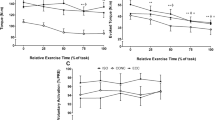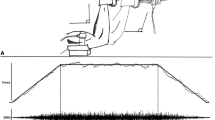Abstract
Purpose
Changes in elbow flexion torque and biceps brachii electromyogram (EMG) activity over 30 repetitive maximal voluntary concentric-only (CON-only), eccentric-only (ECC-only), and alternative concentric and eccentric (CON-ECC, 30 concentric + 30 eccentric) contractions were examined to compare their muscle fatigue profiles.
Methods
Fifteen healthy young men performed CON-only, ECC-only and CON-ECC in their maximal effort between 10° and 100° elbow flexion on an isokinetic dynamometer at an angular velocity of 30°/s with a 3-s rest between contractions in a randomised order with ≥ 3 days between conditions. Changes in torque and EMG over the repeated contractions and maximal voluntary isometric contraction (MVC-ISO) torque with EMG before the first contraction and immediately after the last contraction were compared among conditions by two-way repeated measures analysis of variance.
Results
The torque decreased (p < 0.01) from the first to 30th contraction in CON-only (− 49.5 ± 11.0%), ECC-only (− 32.2 ± 7.4%), and concentric (− 62.3 ± 8.7%) as well as eccentric phase (− 58.9 ± 9.3%) in CON-ECC (− 46.0 ± 12.3% overall). The magnitude of the decrease in the torque was greater (p < 0.01) for the CON-only than ECC-only, and the concentric than an eccentric phase in the CON-ECC. However, MVC-ISO torque decreased (p < 0.01) similarly after CON-only (− 42.9 ± 13.8%) and ECC-only (− 40.1 ± 9.2%), which was smaller (p < 0.01) than CON-ECC (− 56.8 ± 9.2%). EMG over contractions decreased (p < 0.01) for all conditions similarly from the first to the last contraction (− 28.5 ± 26.8%), and EMG in MVC-ISO also decreased similarly for all conditions (− 24.7 ± 35.8%).
Conclusion
These results suggest greater fatigue resistance in repetitive maximal eccentric than concentric contractions, but the fatigue assessed by MVC-ISO does not show it.





Similar content being viewed by others
Data availability
All data generated or analysed during this study are included in the article.
Abbreviations
- ANOVA:
-
Analysis of variance
- EMG:
-
Electromyogram
- ES:
-
Effect size
- MVC-CON:
-
Maximum voluntary isometric contraction
- MVC-ECC:
-
Maximum voluntary eccentric contraction
- MVC-ISO:
-
Maximum voluntary concentric contraction
- POST:
-
Immediately after intervention
- PRE:
-
Before intervention
- RMS:
-
Root mean square
- SD:
-
Standard deviation
References
Abbott BC, Bigland B, Ritchie JM (1952) The physiological cost of negative work. J Physiol 117(3):380–390. https://doi.org/10.1113/jphysiol.1952.sp004755
Baudry S, Klass M, Pasquet B, Duchateau J (2007) Age-related fatigability of the ankle dorsiflexor muscles during concentric and eccentric contractions. Eur J Appl Physiol 100(5):515–525. https://doi.org/10.1007/s00421-006-0206-9
Chen TC, Hsieh SS (2001) Effects of a 7-day eccentric training period on muscle damage and inflammation. Med Sci Sports Exerc 33(10):1732–1738. https://doi.org/10.1097/00005768-200110000-00018
Chen TC, Tseng WC, Huang GL, Chen HL, Tseng KW, Nosaka K (2017) Superior effects of eccentric to concentric knee extensor resistance training on physical fitness, insulin sensitivity and lipid profiles of elderly men. Front Physiol 8:209. https://doi.org/10.3389/fphys.2017.00209
Cohen J (2013) Statistical power analysis for the behavioral sciences. Routledge
Čretnik K, Pleša J, Kozinc Ž, Löfler S, Šarabon N (2022) The effect of eccentric vs traditional resistance exercise on muscle strength, body composition, and functional performance in older adults: a systematic review with meta-analysis. Front Sports Act Living 4:873718. https://doi.org/10.3389/fspor.2022.873718
Doss WS, Karpovich PV (1965) A comparison of concentric, eccentric, and isometric strength of elbow flexors. J Appl 20(2):351–353. https://doi.org/10.1152/jappl.1965.20.2.351
Drust B, Rasmussen P, Mohr M, Nielsen B, Nybo L (2005) Elevations in core and muscle temperature impairs repeated sprint performance. Acta Physiol Scand 183(2):181–190. https://doi.org/10.1111/j.1365-201X.2004.01390.x
Enoka RM, Duchateau J (2008) Muscle fatigue: what, why and how it influences muscle function. J Physiol 586(1):11–23. https://doi.org/10.1113/jphysiol.2007.139477
Folland JP, Irish CS, Roberts JC, Tarr JE, Jones DA (2002) Fatigue is not a necessary stimulus for strength gains during resistance training. Br J Sports Med 36(5):370–373. https://doi.org/10.1136/bjsm.36.5.370
François B (2011) Electromyography assessment of muscle recruitment strategies during high-intensity exercise. In: Joseph M (ed) Advances in applied electromyography. IntechOpen, Rijeka, p 2. https://doi.org/10.5772/24358
Fürst DO, Osborn M, Nave R, Weber K (1988) The organization of titin filaments in the half-sarcomere revealed by monoclonal antibodies in immunoelectron microscopy: a map of ten nonrepetitive epitopes starting at the Z line extends close to the M line. J Cell Biol 106(5):1563–1572. https://doi.org/10.1083/jcb.106.5.1563
Guilhem G, Cornu C, Guével A (2010) Neuromuscular and muscle-tendon system adaptations to isotonic and isokinetic eccentric exercise. Ann Phys Rehabil Med 53(5):319–341. https://doi.org/10.1016/j.rehab.2010.04.003
Herzog W (2014) Mechanisms of enhanced force production in lengthening (eccentric) muscle contractions. J Appl Physiol 116(11):1407–1417. https://doi.org/10.1152/japplphysiol.00069.2013
Herzog W (2018) Why are muscles strong, and why do they require little energy in eccentric action? J Sport Health Sci 7(3):255–264. https://doi.org/10.1016/j.jshs.2018.05.005
Hortobágyi T, Katch FI (1990) Eccentric and concentric torque-velocity relationships during arm flexion and extension. Influence of strength level. Eur J Appl Physiol Occup Physiol 60(5):395–401. https://doi.org/10.1007/bf00713506
Kay D, St Clair Gibson A, Mitchell MJ, Lambert MI, Noakes TD (2000) Different neuromuscular recruitment patterns during eccentric, concentric and isometric contractions. J Electromyogr Kinesiol 10(6):425–431. https://doi.org/10.1016/s1050-6411(00)00031-6
Kossev A, Christova P (1998) Discharge pattern of human motor units during dynamic concentric and eccentric contractions. Electroencephalogr Clin Neurophysiol 109(3):245–255. https://doi.org/10.1016/s0924-980x(98)00012-5
Lastayo PC, Reich TE, Urquhart M, Hoppeler H, Lindstedt SL (1999) Chronic eccentric exercise: improvements in muscle strength can occur with little demand for oxygen. Am J Physiol 276(2):R611-615. https://doi.org/10.1152/ajpregu.1999.276.2.R611
Nuzzo JL, Nosaka K (2022) Comment on: Stepwise load reduction rraining: a new trainingconcept for skeletal muscle and energy systems". Sports Med 2022:1–4. https://doi.org/10.1007/s40279-022-01661-8
Pasquet B, Carpentier A, Duchateau J, Hainaut K (2000) Muscle fatigue during concentric and eccentric contractions. Muscle Nerve 23(11):1727–1735. https://doi.org/10.1002/1097-4598(200011)23:11%3c1727::aid-mus9%3e3.0.co;2-y
Peñailillo L, Blazevich A, Numazawa H, Nosaka K (2013) Metabolic and muscle damage profiles of concentric versus repeated eccentric cycling. Med Sci Sports Exerc 45(9):1773–1781. https://doi.org/10.1249/MSS.0b013e31828f8a73
Roig M, O’Brien K, Kirk G, Murray R, McKinnon P, Shadgan B, Reid WD (2009) The effects of eccentric versus concentric resistance training on muscle strength and mass in healthy adults: a systematic review with meta-analysis. Br J Sports Med 43(8):556–568. https://doi.org/10.1136/bjsm.2008.051417
Royer N, Nosaka K, Doguet V, Jubeau M (2022) Neuromuscular responses to isometric, concentric and eccentric contractions of the knee extensors at the same torque-time integral. Eur J Appl Physiol 122(1):127–139. https://doi.org/10.1007/s00421-021-04817-y
Ruas CV, Latella C, Taylor JL, Haff GG, Nosaka K (2022) Comparison between eccentric-only and coupled concentric-eccentric contractions for neuromuscular fatigue and muscle damage. Med Sci Sports Exerc 54(10):1635–1646. https://doi.org/10.1249/mss.0000000000002959
Sato S, Yoshida R, Murakoshi F, Sasaki Y, Yahata K, Kasahara K, Nunes JP, Nosaka K, Nakamura M (2022a) Comparison between concentric-only, eccentric-only, and concentric-eccentric resistance training of the elbow flexors for their effects on muscle strength and hypertrophy. Eur J Appl Physiol. https://doi.org/10.1007/s00421-022-05035-w
Sato S, Yoshida R, Murakoshi F, Sasaki Y, Yahata K, Nosaka K, Nakamura M (2022b) Effect of daily 3-s maximum voluntary isometric, concentric or eccentric contraction on elbow flexor strength. Scand J Med Sci Sports. https://doi.org/10.1111/sms.14138
Shibata K, Yamaguchi T, Takizawa K, Nosaka K (2023) Comparison in repetitions to failure between concentric-only and eccentric-only dumbbell arm curl exercise at four different relative intensities. J Strength Cond Res. https://doi.org/10.1519/jsc.0000000000004470
Souron R, Nosaka K, Jubeau M (2018) Changes in central and peripheral neuromuscular fatigue indices after concentric versus eccentric contractions of the knee extensors. Eur J Appl Physiol 118(4):805–816. https://doi.org/10.1007/s00421-018-3816-0
Tesch PA, Dudley GA, Duvoisin MR, Hather BM, Harris RT (1990) Force and EMG signal patterns during repeated bouts of concentric or eccentric muscle actions. Acta Physiol Scand 138(3):263–271. https://doi.org/10.1111/j.1748-1716.1990.tb08846.x
Tseng WC, Nosaka K, Tseng KW, Chou TY, Chen TC (2020) Contralateral effects by unilateral eccentric versus concentric resistance training. Med Sci Sports Exerc 52(2):474–483. https://doi.org/10.1249/mss.0000000000002155
Wu Y, Li RC, Maffulli N, Chan KM, Chan JL (1997) Relationship between isokinetic concentric and eccentric contraction modes in the knee flexor and extensor muscle groups. J Orthop Sports Phys Ther 26(3):143–149. https://doi.org/10.2519/jospt.1997.26.3.143
Yoshida R, Sato S, Kasahara K, Murakami Y, Murakoshi F, Aizawa K, Koizumi R, Nosaka K, Nakamura M (2022) Greater effects by performing a small number of eccentric contractions daily than a larger number of them once a week. Scand J Med Sci Sports. https://doi.org/10.1111/sms.14220
Acknowledgements
The authors gratefully acknowledge all participants involved in this study.
Funding
This work was supported by JSPS KAKENHI #19K19890 (Masatoshi Nakamura).
Author information
Authors and Affiliations
Contributions
RY, KN and MN designed the study. RY, KK, YM and SS collected the data, and RY, KN and MN analysed the data, drafted and revised the manuscript. All authors approved the final version of the manuscript and agreed to be accountable for all aspects of the work.
Corresponding author
Ethics declarations
Conflict of interest
The authors declare that they have no conflict of interest.
Research involving human participants
All procedures in the study were in accordance with the ethical standards of the institutional ethics committee. This study was approved by the Ethics Committee of Niigata University of Health and Welfare (#18202).
Informed consent
Informed consent was obtained from each participant involved in the study.
Additional information
Communicated by Michalis G Nikolaidis.
Publisher's Note
Springer Nature remains neutral with regard to jurisdictional claims in published maps and institutional affiliations.
Rights and permissions
Springer Nature or its licensor (e.g. a society or other partner) holds exclusive rights to this article under a publishing agreement with the author(s) or other rightsholder(s); author self-archiving of the accepted manuscript version of this article is solely governed by the terms of such publishing agreement and applicable law.
About this article
Cite this article
Yoshida, R., Kasahara, K., Murakami, Y. et al. Less fatiguability in eccentric than concentric repetitive maximal muscle contractions. Eur J Appl Physiol 123, 1553–1565 (2023). https://doi.org/10.1007/s00421-023-05178-4
Received:
Accepted:
Published:
Issue Date:
DOI: https://doi.org/10.1007/s00421-023-05178-4




